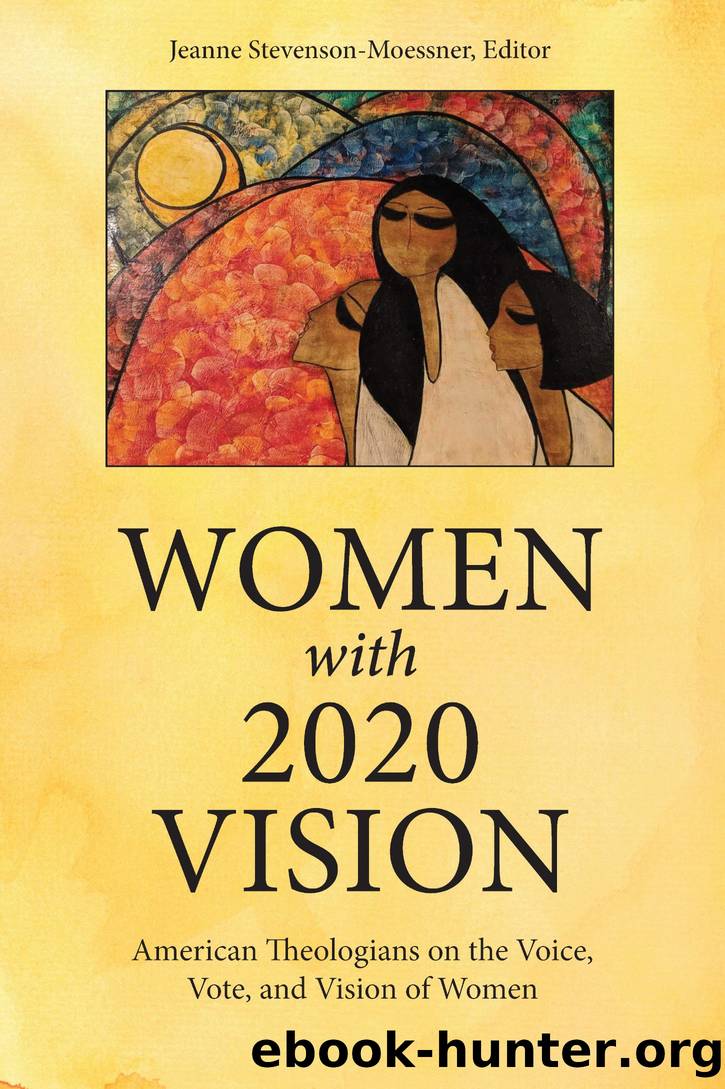Women with 2020 Vision by Jeanne Stevenson-Moessner and

Author:Jeanne Stevenson-Moessner and [and, Jeanne]
Language: eng
Format: epub
Published: 2020-09-07T00:00:00+00:00
Mary, Mother of God, and Space to Appear
An example can be found in the story of Mary, the mother of Jesus. Through Mary, in the birth of her son Jesus, salvation is given to many others because she is first given the power to decide whether to carry a child out of wedlock. She exercises this power. Looking closely at the infancy narrative in the Gospel of Luke as interpreted by Hak C. Kim, we will see how God, through the angel Gabrielâs visit with Mary, creates the conditions for the space of appearance where Maryâs dignity is respected, her agency is valued, and she is free to exercise the power to choose.[28]
Mary is an ordinary young woman living in a patriarchal culture in the region of Palestine and engaged to be married to a man named Joseph. She is neither wealthy nor powerful. Rather, she describes herself as among the lowest of Godâs maidservants (Luke 1:48 NRSV). She is from Nazareth in Galilee, a remote and insignificant city far from privilege and power. Mary is one of two persons in Lukeâs Gospel visited by Gabriel, an angel of the Lord. He first visits Zechariah, a priest in the order of Aaron, to announce that his wife, Elizabeth, will bear a son in her advanced age. An undisclosed amount of time later, Gabriel visits Mary and proceeds to tell of âGodâs universal plan of salvation at Luke 1:30â33.â[29] Mary is confused by this statement. The angel, maybe sensing her fear, says, âDo not be afraid, Mary, for you have found favor with Godâ (1:30). Kim explains that as Gabriel continues to relay Godâs message, a dialogue takes place between him and Mary.[30] Mary is puzzled and asks, âHow can this be, since I am a virgin?â (1:34). Gabriel explains how God will fulfill Godâs plan (1:35) and adds, âFor nothing will be impossible with Godâ (1:37).
Kim compares Gabrielâs approach to Zechariah and to Mary.[31] While the angel announces the birth of John to Zechariahânot ElizabethâMaryâs full presence is acknowledged by Gabrielâs visit to her directly. Gabriel respects Maryâs dignity and awaits her response. Mary uses her own agency and accepts Godâs proposition by replying, âHere am I, the servant of the Lord; let it be with me according to your wordâ (1:38). In other words, conditions were created to give Mary, a vulnerable woman and a lowly maidservant of God, space to âappear,â to come into her full presence with full dignity, and empowering her to use her full agency to choose. Kim contrasts this with Gabrielâs approach to Zechariah: Not only does Mary have her own voice, but God does not force her to do anything or simply inform her of what will happen. Rather, God invites her to participate in the decision-making process regarding the coming of Jesus.[32] In implementing Godâs plan to save Godâs people, God respects Maryâs dignity and her right to choose what will happen to her body. Then, when Mary has given her acceptance, the angel leaves her (1:38).
Download
This site does not store any files on its server. We only index and link to content provided by other sites. Please contact the content providers to delete copyright contents if any and email us, we'll remove relevant links or contents immediately.
The 5 Love Languages: The Secret to Love That Lasts by Gary Chapman(9291)
The Space Between by Michelle L. Teichman(6579)
Assassin’s Fate by Robin Hobb(5858)
Wiseguy by Nicholas Pileggi(5323)
Everything Happens for a Reason by Kate Bowler(4480)
Gerald's Game by Stephen King(4379)
Pillow Thoughts by Courtney Peppernell(4020)
A Simplified Life by Emily Ley(3971)
The Power of Positive Thinking by Norman Vincent Peale(3865)
Resisting Happiness by Matthew Kelly(3197)
Girl, Wash Your Face by Rachel Hollis(3127)
Harry Potter and the Prisoner of Azkaban (Book 3) by J. K. Rowling(3115)
Being Aware of Being Aware by Rupert Spira(3087)
Real Sex by Lauren F. Winner(2869)
The Code Book by Simon Singh(2864)
More Language of Letting Go: 366 New Daily Meditations by Melody Beattie(2851)
Name Book, The: Over 10,000 Names--Their Meanings, Origins, and Spiritual Significance by Astoria Dorothy(2841)
The Holy Spirit by Billy Graham(2778)
The Secret Power of Speaking God's Word by Joyce Meyer(2755)
